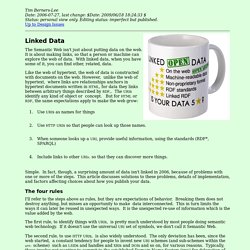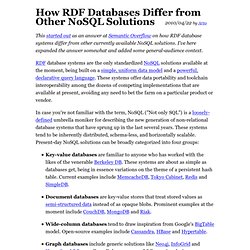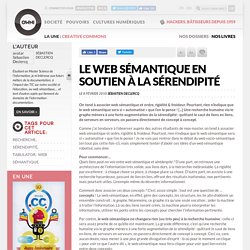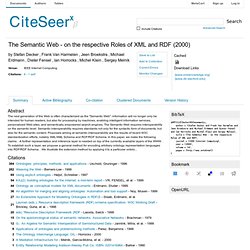

Linked Data - Design Issues. Up to Design Issues The Semantic Web isn't just about putting data on the web.

It is about making links, so that a person or machine can explore the web of data. With linked data, when you have some of it, you can find other, related, data. Like the web of hypertext, the web of data is constructed with documents on the web. However, unlike the web of hypertext, where links are relationships anchors in hypertext documents written in HTML, for data they links between arbitrary things described by RDF,. Use URIs as names for things Use HTTP URIs so that people can look up those names. Simple. The four rules I'll refer to the steps above as rules, but they are expectations of behavior. The first rule, to identify things with URIs, is pretty much understood by most people doing semantic web technology. The second rule, to use HTTP URIs, is also widely understood. The basic format here for RDF/XML, with its popular alternative serialization N3 (or Turtle).
Semantic Web roadmap. Up to Design Issues A road map for the future, an architectural plan untested by anything except thought experiments.

This was written as part of a requested road map for future Web design, from a level of 20,000ft. It was spun off from an Architectural overview for an area which required more elaboration than that overview could afford. Necessarily, from 20,000 feet, large things seem to get a small mention. It is architecture, then, in the sense of how things hopefully will fit together. This document is a plan for achieving a set of connected applications for data on the Web in such a way as to form a consistent logical web of data (semantic web). Introduction The Web was designed as an information space, with the goal that it should be useful not only for human-human communication, but also that machines would be able to participate and help.
It follows the note on the architecture of the Web, which defines existing design decisions and principles for what has been accomplished to date. What is RDF and what is it good for? How RDF Databases Differ from Other NoSQL Solutions - The Datagraph Blog. This started out as an answer at Semantic Overflow on how RDF database systems differ from other currently available NoSQL solutions.

I've here expanded the answer somewhat and added some general-audience context. RDF database systems are the only standardized NoSQL solutions available at the moment, being built on a simple, uniform data model and a powerful, declarative query language. These systems offer data portability and toolchain interoperability among the dozens of competing implementations that are available at present, avoiding any need to bet the farm on a particular product or vendor. In case you're not familiar with the term, NoSQL ("Not only SQL") is a loosely-defined umbrella moniker for describing the new generation of non-relational database systems that have sprung up in the last several years.
These systems tend to be inherently distributed, schema-less, and horizontally scalable. RDF database systems form the largest subset of this last NoSQL category. Le web sémantique en soutien à la sérendipité. On tend à associer web sémantique et ordre, rigidité & froideur.

Pourtant, rien n’indique que le web sémantique sera si « automatisé » que l’on le pense ! [...] Une recherche humaine via le graphe mènera à une forte augmentation de la sérendipité : quittant le saut de liens en liens, de serveurs en serveurs, on passera directement de concept à concept. Comme j’ai tendance à l’observer auprès des autres étudiants de mon master, on tend à associer web sémantique et ordre, rigidité & froideur.
Pourtant, rien n’indique que le web sémantique sera si « automatisé » que l’on le pense ! Pour commencer… Quels liens peut-on voir entre web sémantique et sérédenpité ? Comment donc associer ces deux concepts ? Par contre, le web sémantique ne changera rien (ou très peu) à la recherche humaine : celle-ci sera assez proche de ce qu’elle est maintenant. Pour rendre ça plus concret : La sérendipité par concepts est effectivement accrue, car on n’est plus limité par une indexation manuelle. The Semantic Web - on the respective Roles of XML an. BibTeX Bookmark OpenURL Abstract The next generation of the Web is often characterized as the "Semantic Web": information will no longer only be intended for human readers, but also for processing by machines, enabling intelligent information services, personalized Web-sites, and semantically empowered search-engines.

The Semantic Web requires interoperability on the semantic level. Citations.